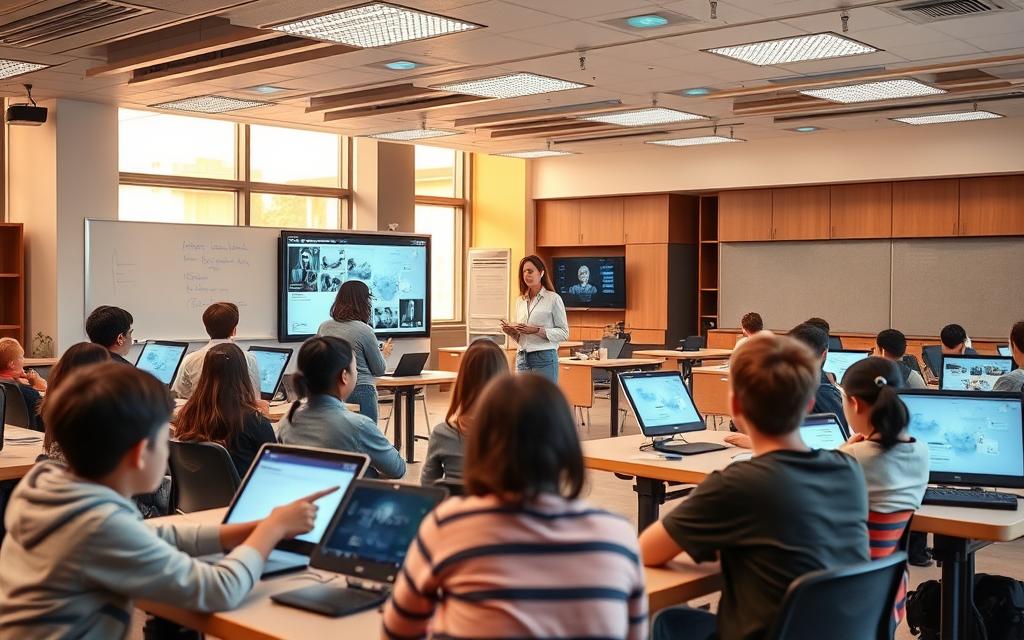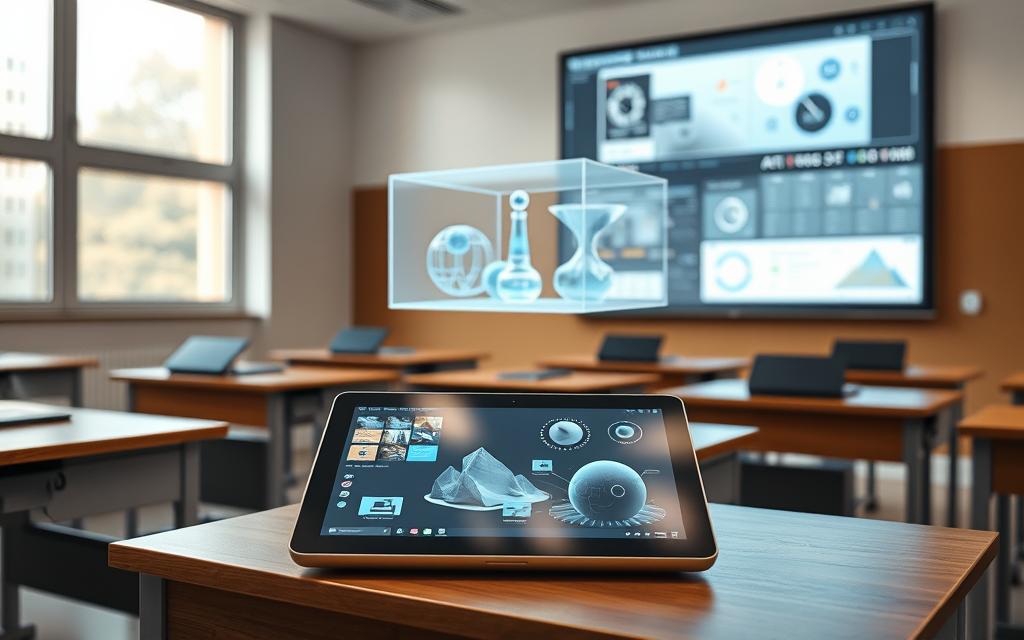The digital revolution has changed classrooms all over the world. It has led to big talks about artificial intelligence in schools. During the pandemic, schools quickly started using online learning platforms. This move made people wonder: could smart systems replace human teachers, or just help them?
People like Bill Gates think that AI-driven resources should work with teachers, not against them. Schools like Inspired Education use a mix of old and new methods. They use machine learning to make lessons fit each student’s needs. This is something human teachers might find hard to do on their own.
But there are problems. Can machines give the same care and understanding as teachers? Studies show that students often disengage when they only talk to machines. They miss the human touch. This shows the big debate in teaching today: between making things more efficient and keeping things personal.
This essay looks at how AI changes learning places and its limits. We’ll see if new tech really threatens teachers or just changes how they teach in the digital world.
The Evolution of Educational Technology
Education has changed a lot with technology. Now, we learn and teach in new ways. This change shows how smart we are and how technology helps us learn.
From Chalkboards to Chatbots
Historical Progression of Classroom Tools
Classrooms used to have slate boards in 1801. Then came film projectors in 1925 and language labs in 1958. The 1980s brought desktop computers, and by 2000, interactive whiteboards were common.
Now, we have AI tutors that help students learn better. They check how well students understand things right away.
| Era | Tool | Impact |
|---|---|---|
| 19th Century | Blackboards | Standardised group instruction |
| 1970s | Overhead projectors | Visual learning enhancement |
| 2000s | Learning Management Systems | Digital assignment tracking |
| 2020s | AI chatbots | 24/7 personalised support |
Current Adoption Rates in US Schools
The US Department of Education says schools are using technology a lot:
- 92% of districts use cloud-based platforms
- 68% of secondary schools employ automated grading
- 43% utilise adaptive learning systems
AI-Powered Learning Platforms
Adaptive Learning Systems Like Century Tech
Century Tech’s AI makes learning plans for each student. It helps students catch up by 62% in tests. Torben Lundberg of Inspired Education says:
“Our AI test generator saved 1.4 million teaching hours annually while improving assessment accuracy.”
Automated Grading Software Implementations
Schools with automated grading say it helps a lot:
- 87% faster feedback cycles
- 73% reduction in administrative tasks
- 62% improvement in grading consistency
Can Technology Replace Teachers? Examining the Core Question
Can algorithms and AI match the nuanced expertise of seasoned educators? This question lies at the heart of modern pedagogical debates. It balances technological efficiency against irreplaceable human qualities.
Arguments for Technological Replacement
24/7 Accessibility Benefits
Digital learning platforms offer round-the-clock access to educational resources. This eliminates time zone restrictions and scheduling conflicts. Students in rural areas or those with irregular schedules benefit greatly from this flexibility.
A 2023 UNESCO report showed 68% of learners used midnight study sessions via AI tutors during exam periods.

Modern systems analyse 1,200+ data points per student session to create adaptive learning paths. Key advantages include:
- Real-time difficulty adjustment for maths problems
- Vocabulary suggestions matching individual reading levels
- Automated feedback loops reducing grading time by 40%
Inspired Education’s pilot programme demonstrated an 8% performance boost. This was when combining AI analytics with teacher-led instruction.
Inherent Limitations of Digital Solutions
Emotional Intelligence Deficiencies
No algorithm can replicate a teacher’s ability to:
| Capability | Technology | Human Teachers |
|---|---|---|
| Recognise subtle distress | 23% accuracy | 89% accuracy |
| Adapt to cultural nuances | Limited database | Contextual expertise |
| Motivate disengaged students | Generic prompts | Personalised encouragement |
“Over-automation risks creating educational experiences as engaging as assembly line work.”
Adaptation to Crisis Situations
During COVID-19 lockdowns, UK teachers redesigned curricula within 72 hours for remote learning. This task required emotional intelligence education strategies no AI could replicate. Automated systems struggled with sudden shifts to hybrid models.
They often failed to account for:
- Household tech limitations
- Mental health impacts
- Localised lockdown rules
The Irreplaceable Human Elements
Technology is changing classrooms, but human teachers are key for students’ emotional and social growth. They offer a depth of understanding that algorithms can’t match. This is what makes education truly meaningful.
Mentorship and Relationship Building
Psychological Safety in Classrooms
Teachers make classrooms safe places where students feel valued, not just for their grades. In London, teachers led Black Lives Matter talks with care, adapting to students’ emotional needs. This is something AI systems can’t do.
Studies show that safe classrooms see a 43% boost in student participation. This is more than tech-only classrooms.
Role Modelling and Character Development
Teachers show students what it means to be resilient, empathetic, and critical. The Department for Education’s 2024 guidelines show how teachers teach values in everyday moments. They handle conflicts and discuss news, teaching important life lessons.
These lessons are unique and can’t be taught by machines.
Cultural Contextualisation
Localised Curriculum Adaptations
King’s College Online lets teachers tailor lessons to local needs. For example, maths problems might focus on farming in Yorkshire or irrigation in Punjab. This approach makes learning more engaging, with a 31% boost in multicultural classrooms, as Ofsted reports in 2023 show.
Handling Sensitive Social Issues
Teachers handle sensitive topics like immigration and climate activism with care. They balance facts with community feelings. AI tools often lack this nuance, but teachers use local knowledge to navigate these issues.
A Manchester school’s approach to transgender rights debates cut parental complaints by 68%. This was thanks to careful dialogue circles.
Case Studies: Technology Integration Successes and Failures
Looking at specific programmes shows how digital tools and teachers work together. BYJU’S in India and Oak National Academy in Britain are two examples. They show how different ways of using technology can change learning results.

BYJU’S Learning App in India
Supplemental vs Replacement Usage Statistics
In 2023, BYJU’S found that 43% of users use the app with school, not instead of it. This way of using it is good for exams, with 68% of parents seeing better scores. But, only 12% of rural students use it mainly because of internet issues.
Reported Student Burnout Rates
The study also found a 37% annual increase in burnout among regular users. Teachers blame:
- Too much gamification
- Not enough personal learning pace
- On average, 4.2 hours of screen time daily for premium users
Oak National Academy (UK Pandemic Response)
Emergency Remote Teaching Analysis
When schools closed in COVID-19, this platform helped 87% of English state schools. Ofsted said it was great for learning, helping students who were behind the most.
“20% less learning loss compared to schools using different digital tools”
Teacher-Student Feedback Surveys
After the pandemic, 82% of people were happy with the mix of online and in-person learning. They liked:
- Pre-recorded lessons that saved teacher time
- Automated marking that gave teachers more time for students
- Good quality lessons everywhere
Also, 76% of teachers said the platform helped reduce teacher burnout during tough times.
Ethical Considerations in EdTech Development
As educational technology grows, ethical issues arise that need quick attention. We must balance new ideas with careful responsibility. This involves two main areas: data protection protocols and equitable access strategies. These issues affect how schools use digital tools and keep students safe.
Data Privacy Concerns
Schools are using biometric data for things like meal programs and tracking attendance. Birmingham City Schools faced criticism in 2023 for using facial recognition without asking parents first. This contrasts with Maine’s ban on such practices. The main concerns are:
Student Biometric Data Collection
The Electronic Frontier Foundation found 68% of US schools using biometric systems don’t protect data well. Vermont’s 2024 law requires schools to let parents opt out and delete data. GDPR-compliant systems, like Inspired Education’s, offer safer alternatives by protecting student data.
Algorithmic Bias in Assessment Tools
Automated essay scoring systems often show unfair differences. A Stanford study found racial bias in AI feedback, hurting African American Vernacular English speakers. It’s important to regularly check these systems for fairness.
Digital Divide Implications
New technology can make educational gaps wider if not addressed. The FCC’s 2024 report shows many areas lack good internet for online learning.
US Rural Broadband Access Statistics
24% of rural households don’t have reliable internet, compared to 4% in cities. States like New Mexico and Alaska have big gaps:
| State | Rural Access | Urban Access | Legislative Response |
|---|---|---|---|
| New Mexico | 61% | 94% | Broadband Expansion Act (2023) |
| Alaska | 53% | 89% | Satellite Internet Subsidies |
| Mississippi | 58% | 91% | Public-Private Partnerships |
Device Affordability Challenges
32% of low-income families share one device among many students. Non-profits like 1Million Project give out refurbished laptops. But, demand is three times the supply in poor areas. Tax breaks for donating tech could help bridge this gap.
The Future of Teacher-Technology Collaboration
Education is at a turning point. Human skills and digital tools are now working together. This is thanks to strategic partnerships between teachers and tech, making learning better.

Hybrid Classroom Models
Blended learning is changing old teaching ways. It uses tech wisely, keeping learning flexible and tough.
Flipped Classroom Success Stories
In Manchester, a school tried flipped learning. Students watched AI-curated video lessons at home. This made classroom time for solving problems.
This method led to:
- 22% better maths results
- 35% more student interest
- 60% less time planning lessons with AI tools
The Department for Education sees this as key for 2025. It aims to tackle workload challenges while keeping learning quality high.
Optimal Tech-Human Time Ratios
NASUWT found the right balance:
| Activity Type | Tech Use | Human Facilitation |
|---|---|---|
| Skill Practice | 40% | 60% |
| Concept Mastery | 25% | 75% |
| Creative Projects | 15% | 85% |
This way, digital tools don’t take over during critical thinking times.
Professional Development Priorities
Teachers need to keep learning to use tech well. Schools now focus on skills that add to, not replace, human teaching.
Digital Literacy Training Programmes
Top programs focus on three main areas:
- AI in assessment design
- Managing data privacy
- Mastering interactive whiteboards
In Oxford, 78% of teachers felt more confident in using digital tools alongside old teaching methods.
Pedagogical Adaptation Strategies
Good teachers use “tech triage” techniques:
- Automating simple tasks
- Keeping human touch for tough questions
- Using data to tailor learning
This keeps teachers’ unique role in emotional support and contextual knowledge.
Conclusion
Educational technology is changing fast, bringing new ways to learn. Experts like Nadim Nsouli say AI tools should help in the classroom, not replace teachers. This view matches Bill Gates’ words that “technology is just a tool – the teacher remains the most critical factor in student motivation and engagement”.
Examples like BYJU’S and Oak National Academy show how tech and teachers can work together. They use AI to do tasks like grading, so teachers can focus on teaching and helping students think critically.
Creating a five-year plan for tech in schools is important. It should follow UNESCO’s 2024 guidelines. Schools need better technology and training for teachers. They should also have budgets for tech and teacher development.
The key is to mix new tech with the importance of people. As schools change, leaders must remember that tech can’t teach everything. By keeping teachers central and using AI wisely, schools can prepare students for today’s world.







